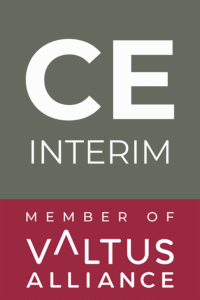Not enough time to read the full article? Listen to the summary in 2 minutes.
Stepping into a role of Interim financial executives during a crisis is like taking the helm of a ship in a hurricane. The pressure is immense, and the stakes couldn’t be higher. But your financial expertise is exactly what the company needs to weather this storm.
This comprehensive guide is your lifeline, providing a step-by-step plan to not just survive but excel in this demanding role. Get ready to turn challenges into opportunities and lead your company to success.
Part I: The First 48 Hours – Rapid Assessment & Prioritization
The clock is ticking. Your first two days are crucial for understanding the situation and setting the foundation for effective crisis management. Here’s a step-by-step guide to help you navigate this critical period:
I) Immediate Financial Health Check:
Dive into the company’s financial records. Assess the cash situation to determine liquidity. How much debt does the company have? Are we operating at a profit or loss? Look for immediate danger signs such as negative cash flow, high debt-to-equity ratios, or missed financial covenants. These indicators will highlight financial vulnerabilities that need urgent attention.
II) Operational Review:
Examine key performance indicators (KPIs) such as revenue trends, gross margins, and operating expenses. Are sales declining? Are expenses spiraling out of control? Additionally, gauge employee morale, as low morale can impact productivity and overall performance. Identifying these issues early will help you prioritize areas that require immediate action to stabilize operations.
III) Risk Assessment:
Conduct a thorough risk assessment to uncover hidden liabilities, potential lawsuits, regulatory issues, or any other risks that could exacerbate the crisis. This involves a meticulous review of contracts, legal documents, and compliance reports. Understanding these risks will equip you with the knowledge needed to mitigate potential threats proactively.
IV) Stakeholder Mapping:
Identify all key stakeholders, including board members, investors, creditors, employees, customers, and suppliers. Take the time to understand their concerns, priorities, and how they might impact the resolution of the crisis. Building strong relationships with stakeholders will be vital in navigating through challenging times and securing their support.
V) Communication Strategy:
Develop a clear and transparent communication plan. It’s essential to keep stakeholders informed with regular updates, outlining the steps you’re taking to address the crisis. Honesty and openness will build trust and confidence, ensuring that everyone is aligned and working towards the same goals.
By following these steps, you’ll be better equipped to handle the initial phase of the crisis with a comprehensive understanding of the company’s financial health, operational status, risks, and stakeholder dynamics. This groundwork will set the stage for effective decision-making and strategic planning as you move forward.
Part II: Stabilizing the Situation – Immediate Actions
In these challenging times, the role of interim Financial Executives, such as Interim CFOs, is crucial. Taking charge and steadying the ship requires a carefully crafted plan to ensure the financial stability of the organization. Here are some detailed steps you can take:
I) Cash Flow Triage:
- Extend Payment Terms: Engage in proactive negotiations with suppliers to extend payment terms. This will allow you to free up cash and create some breathing room for the company.
- Accelerate Collections: Implement stricter credit policies and offer early payment discounts to encourage quicker payments. Aggressively pursue outstanding receivables by setting up a dedicated team or using automated systems to track and follow up on overdue accounts.
- Secure Financing: Explore various short-term financing options such as lines of credit, asset-based loans, or factoring. These can help bridge any immediate cash gaps, ensuring that the company has the liquidity needed to operate smoothly.
II) Cost Reduction:
- Identify Quick Wins: Focus on discretionary spending areas like travel, marketing, and non-essential projects for immediate cuts. By identifying these “quick wins,” you can make significant savings without impacting core business operations.
- Renegotiate Contracts: Review all contracts with suppliers, vendors, and landlords. Look for opportunities to renegotiate terms or secure discounts. This can lead to substantial cost savings over time.
- Streamline Operations: Conduct a thorough analysis of current processes to identify inefficiencies. Implement lean practices to reduce waste and optimize resource utilization. This not only cuts costs but also improves overall operational efficiency.
III) Working Capital Optimization:
- Inventory Management: Optimize inventory levels to reduce carrying costs and free up cash. Implement just-in-time inventory practices where feasible, and regularly review inventory turnover rates to ensure stocks are aligned with demand.
- Receivables Management: Tighten credit policies and offer incentives for early payments to improve cash flow. Actively manage collections by regularly reviewing accounts receivables and following up on overdue payments.
- Payables Management: Strategically delay payments to suppliers while maintaining good relationships. This maximizes cash on hand and provides additional liquidity to manage day-to-day operations.
IV) Financial Forecasting:
- Cash Flow Projections: Develop detailed cash flow forecasts to anticipate future needs and ensure adequate liquidity. Regularly update these projections to reflect changing circumstances and make informed decisions.
- Scenario Planning: Model different scenarios – optimistic, pessimistic, and most likely – to understand the potential impact of various outcomes. Use these scenarios to adjust your strategy and prepare for a range of possibilities.
By implementing these steps, you can help stabilize the financial situation of the organization and lay the groundwork for future recovery and growth. In the role of Interim financial executives your expertise is invaluable in guiding the company through this critical period.
Part III: Charting a Course to Recovery – Strategic Planning
With the immediate crisis under control, it’s crucial to shift our focus towards the future and lay the groundwork for long-term stability and growth. Here’s how we can strategically plan our way to recovery:
I) Financial Restructuring:
- Assessment: Begin by thoroughly assessing the company’s financial needs. This might involve evaluating the necessity of debt restructuring, seeking equity injections, or exploring other forms of recapitalization. The goal is to enhance the company’s financial health and ensure it has the resources needed to move forward.
- Implementation: Once assessment is complete, it’s important to implement the most viable financial strategies. This might include negotiating with creditors for more favorable terms, attracting new investors, or even divesting non-core assets to improve liquidity.
II) Operational Turnaround:
- Identify Root Causes: Conduct a deep dive into the organization’s operations to pinpoint the fundamental causes of the financial distress. This thorough analysis should cover all aspects, from management practices and market dynamics to operational inefficiencies. Understanding these root causes is vital for developing effective solutions.
- Implement Solutions: Based on the findings, develop a comprehensive turnaround plan. This plan should not only address the immediate issues but also lay the foundation for sustainable growth. Implementing these solutions requires coordinated efforts across all departments, ensuring alignment with the company’s overall strategic goals.
III) Growth Initiatives:
- Exploration: The aim is not just to survive the current crisis but to emerge stronger. Investigate potential new revenue streams, explore untapped markets, or consider diversifying the product offerings. This proactive approach can provide new avenues for growth and help the company regain its competitive edge.
- Execution: Carefully plan and execute these growth initiatives. This might involve market research, developing new products, or forming strategic partnerships. The key is to ensure these initiatives are well-aligned with the company’s core strengths and market opportunities.
In summary, recovery is not just about addressing the immediate challenges but also about positioning the company for future success. By focusing on financial restructuring, operational turnaround, and proactive growth initiatives, we can navigate through this crisis and build a stronger, more resilient organization.
Part IV: Communication – Your Most Powerful Tool
Open, honest communication is the cornerstone for the role of interim financial executives, especially during a crisis. Here are some key strategies to consider:
I) Build Trust
Sharing information openly and honestly with all stakeholders is paramount. Acknowledge the challenges your organization is facing and outline your recovery plan transparently. This builds trust and reassures stakeholders that you are in control and have a plan in place.
II) Manage Expectations
It’s crucial to set realistic goals and timelines for recovery. Communicate progress regularly, whether it’s good or bad. By managing expectations, you help prevent surprises and keep everyone aligned and focused.
III) Tailor Your Message
Different audiences require different communication styles. Employees need reassurance and motivation; investors seek data-driven updates and strategic insights; and creditors want to see a clear path to repayment. Adapting your communication to each audience ensures your message is received and understood.
IV) Leverage Technology
In today’s digital age, using technology to facilitate communication is essential. Tools like video conferencing, project management software, and collaboration platforms help keep everyone on the same page and streamline the flow of information.
Part V: Beyond the Crisis – Building a Stronger Future
Emerging from a crisis doesn’t mean your job is done. In fact, it’s just the beginning of a new phase of growth and stability:
I) Mentorship and Knowledge Transfer
Invest in your team by sharing your knowledge and experience. Empowering them to handle future challenges ensures the organization remains financially stable and resilient. Mentorship not only builds a stronger team but also fosters a culture of continuous learning and improvement.
II) Process Improvement
Implementing robust financial controls, risk management processes, and reporting systems is crucial to prevent future crises. These improvements ensure compliance and provide a solid foundation for the organization to thrive.
III) Smooth Transition
As an interim CFO, part of your role is to assist in the search for a permanent CFO and ensure a seamless handover. Your goal should be to leave the company in a better position than you found it, with systems and processes in place that will set your successor up for success.
Conclusion
Your role of interim financial executives is demanding but highly rewarding. Your expertise can make a tangible difference in a company’s ability to weather financial storms and emerge stronger. Embrace the challenge, leverage your skills, and remember that you are not alone. Lean on your team, your mentors, and your network for support. Together, you can navigate any crisis and secure a brighter financial future for the organization.
At CE Interim, we specialize in providing interim managers, including interim CFOs, to businesses facing crises. We also assist interim managers in finding new clients who need help during challenging times.
Your journey as an interim CFO is not just about managing numbers; it’s about leading with integrity, fostering trust, and building a legacy that will endure long after the crisis has passed.





